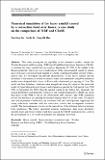Numerical simulation of the heavy rainfall caused by a convection band over Korea: a case study on the comparison of WRF and CReSS
Author(s)
In, So-Ra; Han, Sang-Ok; Im, Eun Soon
Download11069_2013_Article_779.pdf (1.143Mb)
PUBLISHER_CC
Publisher with Creative Commons License
Creative Commons Attribution
Terms of use
Metadata
Show full item recordAbstract
This study investigates the capability of two numerical models, namely the Weather Research and Forecasting (WRF) and Cloud Resolving Storm Simulator (CReSS), to simulate the heavy rainfall that occurred on September 21, 2010 in the middle of the Korean peninsula. This event was considered part of the typical rainfall caused by intense quasi-stationary convection band, leading to a large accumulated rainfall amount within a narrow area. To investigate the relevant characteristics of this heavy rainfall and the feasibility of the numerical models to simulate them, the experiments using both numerical models were designed with a focus on Korea with a horizontal grid spacing of 2 km. The initial and later boundary conditions were interpolated using the output of the mesoscale model of Japan Meteorological Agency and integration spanned the 24-h period from 2100 UTC on September 20, 2010 when the rainfall started in the Yellow Sea. Generally, the spatial distribution and temporal evolution of the rainfall simulated by CReSS are closer than those of the WRF to the in situ observations (655 stations). The WRF simulation reveals the deficiency in capturing the unusual stagnant behavior of this event. The spatial and vertical patterns of reflectivity are consistent with the rainfall pattern, supporting that strong reflectivity coincides with the convective activity that accompanies excessive rainfall. The thermodynamic structure is the main driver of the different behavior between both simulations. The higher equivalent potential temperature, deep moist absolutely unstable layer and strong veering wind shear seen in the CReSS simulation play a role in the development of a favorable environment for inducing convection.
Date issued
2013-07Department
Singapore-MIT Alliance in Research and Technology (SMART)Journal
Natural Hazards
Publisher
Springer Netherlands
Citation
Im, Eun-Soon, So-Ra In, and Sang-Ok Han. “Numerical Simulation of the Heavy Rainfall Caused by a Convection Band over Korea: a Case Study on the Comparison of WRF and CReSS.” Natural Hazards 69, no. 3 (July 23, 2013): 1681–1695.
Version: Final published version
ISSN
0921-030X
1573-0840